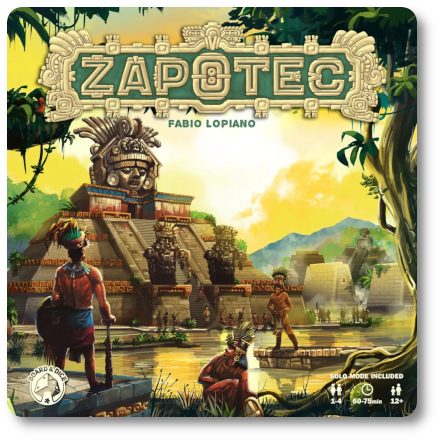 The Basics:
The Basics:
- For ages 12 and up
- For 1 to 4 players
- Approximately 75 minutes to complete
Geek Skills:
- Counting & Math
- Logical & Critical Decision Making
- Strategy & Tactics
- Hand/Resource Management
- Worker Placement & Area Control
Learning Curve:
- Child – Moderate
- Adult – Easy
Theme & Narrative:
- Help build a Pre-Columbian civilization for fun and profit
Endorsements:
- Gamer Geek approved!
- Parent Geek approved!
- Child Geek mixed!
Overview
An Indian politician who served as the sixth prime minister of India, Rajiv Ratna Gandhi, said, “Civilizations are built by the ceaseless toil of a succession of generations. With softness and sloth, civilizations succumb. Let us beware of decadence.” In this game, players must go to work building a pre-Columbian civilization. However, planting crops and feeding the growing population is only part of the goal. Players must also satisfy the increasing populace’s religious needs with towering ziggurats. As the capital expands, the land becomes scarce, and the players must become ever more creative in how they go about maintaining growth.
Zapotec, designed by Fabio Lopiano and published by B0ard & Dice, is comprised of one main game board, four Player boards, 45 Building tiles, four Palace tiles, 36 Trade tiles, nine Scoring tiles, 60 Resource tiles (15 each of Wood, Brick, Stone, and Corn), 15 Coin tokens, 15 Priest tokens, 27 Action cards, 10 Ritual tokens, 27 Cokijoboat cards (used only for solo play), four Reference cards, 36 wooden Houses, 20 wooden discs, 12 small Pyramid pieces, eight medium Pyramid pieces, and four large Pyramid pieces. All the game components are of excellent quality with thick cardboard, thick cardstock, and solid Wood. In addition, artists Zbigniew Umgelter and Aleksander Zawada provide colorful illustrations that make it easy to spot the different resources and further the game’s theme.
Planning a Civilization
To set up the game, complete the following steps. Note that your setup will be different per the number of players in the game, limiting the type and number of tiles and tokens used.
First, place the main gameboard in the middle of the playing area and within easy reach of all the players. A lot is going on here. Players should take a moment to familiarize themselves with the different sections.

Image courtesy of Board and Dice (taken from the official rule book)
Second, separate the Resources into Wood, Brick, Stone, Gold, Corn, and Priests, placing them off one side and within easy reach. These are the Resource pools for the duration of the game.
Third, sort the Building tiles by type (temples, cornfields, and villages). Note that these tiles have two sides. One side shows the type, and the other side shows resources. Next, place the tiles on the main game board with the resource side up. The Building tiles go to the space on the main gameboard that matches the tile’s color (red to red, for example).
Fourth, separate the Trade tiles by the Roman numeral values on the tile’s back (I, II, and III), creating three stacks. These numerical values represent the Trade tile’s level. For example, Level One (I) tiles tend to provide a single resource once in the game, Level Two (II) provide a resource and a unique ability that might be reusable during the game, and Level Three (III) provide a resource and unique ability throughout the entire game). Next, shuffle the stacks and place them face-down on the main gameboard. Then reveal the top three of each stack, placing them face-up in their designated row.
Fifth, randomly draw and place on the main gameboard several Scoring tiles equal to one more than the total number of players. So, for example, if you were playing with four players, you’d draw five Scoring tiles. Any Scoring tiles not used are returned to the game box.
Sixth, shuffle the Action card deck. First, draw one at random and place it face-up to the main gameboard. Then draw several Action cards equal to one more than the total number of players, placing these cards face-up in a row off to the side of the main gameboard. This row is referred to as the “Offer.” Next, draw another four Action cards and place them face-down next to the Offer row. Finally, take the remaining Action cards and deal to the players. The players can look at these cards but should be kept hidden from opponents until played.
Seventh, shuffle the Ritual card deck. Draw three and place them face-up in a row next to the main gameboard. Return any unused Ritual cards to the game box.
Eighth, give each player a Player board. Have each player pick a color of their choice. From that color, have them collect House, Discs, and Pyramid pieces, placing them on their Player board. Next, give each player a Palace tile, one Wood, one Brick, and one Stone. The Player Board (A) top portion offers players a quick reference to what resources are needed to build during a player’s Construction step. The middle left portion of the Player Board (B) is the player’s resource grid which will be filled during gameplay. The middle right portion of the Player Board (C) is where the player stores their Pyramid pieces, Houses, and Temple until they place them on the main game board.
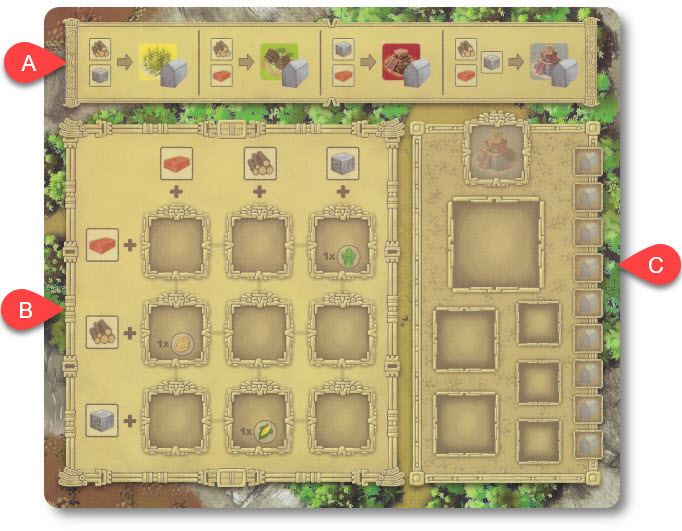
Ninth, have each player take one Disc of their choice and place it to the lowest position of the Sacrifice track and the lowest numerical value of the Scoring track on the main gameboard.
That completes the game setup! Time to build a pre-Columbian civilization!
Civilization Rising
Zapotec is played in rounds and turns for a total of five rounds. Each round consists of phases and steps in which players complete actions simultaneously and individually during their turn. A single round of game play is summarized here.
Phase One: Select Card
All players complete this phase of the round simultaneously, as turn order doesn’t matter here. Players were dealt several Action cards during the game setup and will have an opportunity to get more during the game. These Action cards show three essential things that will define what the player can do during their turn.
The top portion of the Action card (A) defines the resource type and determines the row or column on the Player board resource gride that the player can use this round to collect resources. The middle portion of the Action card (B) defines the property type that determines which areas of the game board the player may build on. For example, the icon shown can represent three different buildings, one of three different regions, or one of three different terrain types. The bottom portion of the Action card (C) determines the turn order sequence for this round. Lower numbers go before higher numbers.
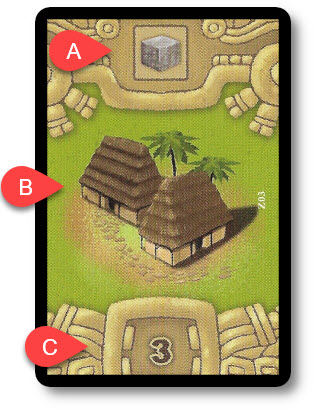
Once the players all select a card and indicate they are ready, all players place them down in front of them, revealing it to their opponents. Turn order is now determined, and each player’s limitations are indicated on their selected Action card.
Phase Two: Income and Actions
After selecting their Action cards, players now have several actions they can take. In the turn order sequence defined by the Action cards, each player will complete an Income, Action, Scoring, and then Draw step, ending their respective turn. Each step is summarized here.
Step A: Collect Income
The player now looks at their Player board and determines which row or column on their resource grid they want to use based on the resource type noted at the top of their Action card, collecting what is shown. Each player’s resource grid contains a default resource they will always get if that specific row or column is selected. As the game progresses, players will take Building tiles from the main gameboard and place them on their resource grid, increasing the number of resources to be collected.
Step B: Actions
There are several actions the player can take during their turn. While they fall under four categories (trade, pyramid, ritual, and sacrifice), they are collectively referred to as “Captial actions.” There is no limit to the number of times or defined order in which a player can take Captial actions. However, they cannot proceed through their turn and onto the next step until they complete all possible Capital actions or announce they are done taking them. It should also be noted that while the players are not restricted in the order in which they take their actions, each player should consider the order in which they take them each round as the resolution of each action immediately influences the player’s turn in the future.
The Trade action allows the player to purchase the available face-up Trade tiles. The amount of Gold the Trade tile costs is based on its Level. Level One costs one Gold, for example. There are only two rules that must be adhered to when purchasing Trade tiles. The first and obvious is that players can only purchase Trade tiles they can pay for. The second is that a player may only purchase one Trade tile from each row once. That is to say, a player couldn’t purchase three Level One Trade tiles, but they could buy one Trade tile from each Level. Purchased Trade tiles are placed in front of the owning player and can be activated during the same turn they were acquired. Note that some of the Trade tiles can only be used once per game, are refreshed each round, and even provide the player a continuous bonus. The game rule book provides a complete description of each Trade tile.
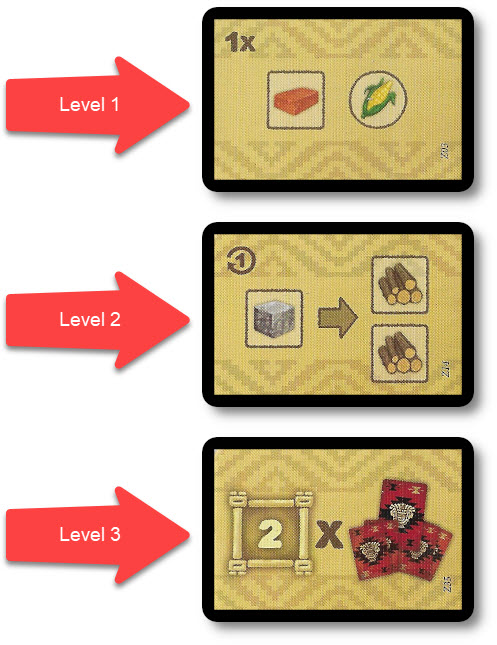
The Pyramid action allows the player to spend one Wood, one Priest, one Brick, and one Stone to take one of their Pyramid pieces from their Player board and build it to the main gameboard. Pyramid pieces “stack” on top of each other, starting with the largest pieces at the bottom and moving up to the smallest of the three pieces. Players must always use their largest possible Pyramid piece first if starting a new Pyramid on an empty space on the main gameboard. Alternatively, players can contribute to an already existing Pyramid by placing the next appropriate size piece. It’s prevalent during a game for these pyramids to be built entirely by more than one player.
The Ritual action is only available to the player if they have built at least one piece of a Pyramid to the main gameboard. The player spends one Priest and places one of their Discs on one of the Ritual cards displayed by the main gameboard. There is no limit to the number of Discs on a Ritual card, but each player can only play to a specific Ritual card once. If the Ritual card has one or more Disc already on it that belong to an opponent, they must pay one Gold per opponent’s Disc to place their Disc to that specific Ritual card. Finally, the number of Ritual cards the player can access is limited by the number of Pyramid pieces they have built as of their turn and when taking this action.
For example, the following Ritual card will reward victory points to players who have Trade tiles at certain levels.
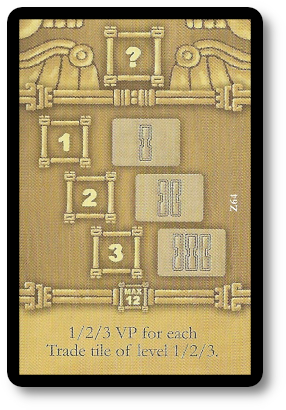
The Sacrifice action (which sounds violent but isn’t) lets the player advance their Disc up the Sacrifice track, acquiring points, resources, and permanent discounts on Trade and Ritual cards. A player spends one Priest and anywhere from one to five Corn. For each Corn, the player moves their Disc up the Sacrifice track. For example, for one Priest and two Corn, the player moves their Disc up two rows on the Sacrifice track, resolving each space as they ascend before continuing to the next.
Step C: Construction
This step allows the player to spend any remaining resources the player might have to build to the main gameboard, effectively claiming control over sections of the area. Where the player can build and what is determined by their Action card. There is no limit to the number of times a player may build during this step.
- If the Action card shows a building type (Village, Temple, Field), they can only build that type but are free to build it to any available region or terrain.
- If the Action card shows a region (Mitla, Ocotlan, or Etla), they can build only to that region but are free to build any available building or terrain.
- If the Action card shows a terrain (Forest, Hills, or Plains), they can build only to that terrain but are free to build any available building or region.
Players can also build their Palace tile using the noted limitations via their played Action card.
The cost to build is noted here, as well as on the Player board:
- Village = one Brick and one Wood
- Temple = one Brick and one Stone
- Field = one Wood and one Stone
- Palance = one Wood, one Brick, and one Stone
If the player can pay for the building and wants to complete this step, they spend the noted resources and place one of their Houses in the space, taking the tile that occupies it for their own. For example, if the player built the Palace, they set their Palace tile with a House on top. The collected tile is then placed on the player’s resource grid to any location on the grid that does not yet have a tile. If the space the tile is placed rewards the player for filling it, they claim that reward now, but only once.
Step D: Turn Scoring
The player now scores two Victory Points for each House they have on the main gameboard that matches the property noted on the current rounds Scoring Action card (not just those they placed this round). Victory Points are tracked and logged using the Scoring track on the main gameboard. For example, a built Palace counts as two Houses.
Step E: Draw Card
The final step on the player’s round is to collect one of the Action cards in the Offer row, adding it to their hand.
End of the Round
After all the players complete Phase Two in the turn order sequence noted by their played Action card, the round ends.
The remaining Action card in the Offer row is moved to the Scoring space on the main gameboard and kept face-up. If there are cards already in the stack, place the new card on top. This is the bonus Action card for the next round.
Finally, collect all the played Action cards, shuffle them to the face-down Action cards, and deal a new Offer row.
A new round now begins starting with Phase One noted above.
Ending the Game
The game comes to an end after the fifth round is completed. Before determining the winner, additional Victory Points are counted.
- The top three players on the Sacrifice track are awarded points based on their current position.
- All players score Victory Points per the Ritual cards their Discs are currently occupying.
- All players score Victory points per their contribution to the Pyramids and Houses.
After all the points are counted, the winner is the player who has the most Victory Points (as noted on the main gameboard).
Game Variant
Zapotec has a “solo mode” that allows the player to compete against an automated opponent that is driven by the outcome of a card deck. The game is set per the requirements of a two-player game. The most significant difference is the Cocijobot deck which determines the actions taken by the automated opponent. Depending on the Action card used by the player, the automated opponent will go first or second. In this way, the solo player can enjoy the game, albeit against an opponent who doesn’t seem to have much in the course of a real strategy.
To learn more about Zapotec, visit the game’s webpage.
Final Word
 The Child Geeks struggled a bit with this game. The rules are straightforward, and the gameplay is swift, which caused the problems. And yes, I know that sounds weird. We observed that the Child Geeks understood the game, but due to how many choices there were – which all seemed like great approaches to victory – they were overwhelmed by what they could accomplish. It was like putting them in front of a row of 31 flavors of ice cream and asking them to pick their favorite. They eventually found their “flavor” of choice, but the game’s length was so short (only five rounds) that it was over before the Child Geeks felt like they had even started. According to one Child Geek, “I finally understood the game at the very end. I’ll play it again, but only after I feel like I have had time to think about it.” Another Child Geek said, “I liked it at first, didn’t like it in the middle, and liked it again when it was over.” All the Child Geeks gave us an initial vote that showed they rejected Zapotec. It was only after their second and third game they had a change of heart. This resulted in the game getting a mixed review from our youngest players.
The Child Geeks struggled a bit with this game. The rules are straightforward, and the gameplay is swift, which caused the problems. And yes, I know that sounds weird. We observed that the Child Geeks understood the game, but due to how many choices there were – which all seemed like great approaches to victory – they were overwhelmed by what they could accomplish. It was like putting them in front of a row of 31 flavors of ice cream and asking them to pick their favorite. They eventually found their “flavor” of choice, but the game’s length was so short (only five rounds) that it was over before the Child Geeks felt like they had even started. According to one Child Geek, “I finally understood the game at the very end. I’ll play it again, but only after I feel like I have had time to think about it.” Another Child Geek said, “I liked it at first, didn’t like it in the middle, and liked it again when it was over.” All the Child Geeks gave us an initial vote that showed they rejected Zapotec. It was only after their second and third game they had a change of heart. This resulted in the game getting a mixed review from our youngest players.
 On the other hand, the Parent Geeks ate this game up (I’m still sticking to the ice cream analogy, apparently). Like the Child Geeks, they quickly learned that each of their turns was important, and they didn’t have many, to begin with. According to one Parent Geek, “I liked this game. It was easy to understand and then wonderfully engaging and complicated without feeling overwhelmed or out of control. Each of my moves – even those by the other players – was important to the game itself and what I wanted to accomplish. Very engaging.” Another Parent Geek said, “A great mix of casual gameplay and deep strategy. I thoroughly enjoyed myself and would play this game again. And it’s so fast! Too fast, I think at times because it felt more times than not that the moment I got my focus, the game was already half over.” When the Parent Geeks voted, the results proved that Zapotec was a winner with the casual and more mature players of our group.
On the other hand, the Parent Geeks ate this game up (I’m still sticking to the ice cream analogy, apparently). Like the Child Geeks, they quickly learned that each of their turns was important, and they didn’t have many, to begin with. According to one Parent Geek, “I liked this game. It was easy to understand and then wonderfully engaging and complicated without feeling overwhelmed or out of control. Each of my moves – even those by the other players – was important to the game itself and what I wanted to accomplish. Very engaging.” Another Parent Geek said, “A great mix of casual gameplay and deep strategy. I thoroughly enjoyed myself and would play this game again. And it’s so fast! Too fast, I think at times because it felt more times than not that the moment I got my focus, the game was already half over.” When the Parent Geeks voted, the results proved that Zapotec was a winner with the casual and more mature players of our group.
 The Gamer Geeks found Zaptec to be a bit of a surprise. According to one Gamer Geek, “I liked it. However, found it to be a bit too quick, considering how much they throw at the player to consider. Honestly, I feel like this game should take about two hours, but most of our games were only an hour long. Still, I always left the table feeling winded because the game flies by you. I’d play this again.” Another Gamer Geek said, “A more casual approach to game mechanics that you normally find in much more complicated games. The game felt a little crazy at times, with all the building and moving and shifting, but it all comes together nicely. I think this would make for a great game for more experienced gamers who wanted something casual but also demanding of their brain.” When the votes were asked for and collected, the result was approval from our gaming elitists.
The Gamer Geeks found Zaptec to be a bit of a surprise. According to one Gamer Geek, “I liked it. However, found it to be a bit too quick, considering how much they throw at the player to consider. Honestly, I feel like this game should take about two hours, but most of our games were only an hour long. Still, I always left the table feeling winded because the game flies by you. I’d play this again.” Another Gamer Geek said, “A more casual approach to game mechanics that you normally find in much more complicated games. The game felt a little crazy at times, with all the building and moving and shifting, but it all comes together nicely. I think this would make for a great game for more experienced gamers who wanted something casual but also demanding of their brain.” When the votes were asked for and collected, the result was approval from our gaming elitists.
 Here’s a free “pro-tip” for you. Always try to be the first player in the turn order sequence. Zapotec is one of those games that rewards those who jump first by offering them all the opportunities, while those who go later tend only to have the scraps of what is left to them. Of course, you won’t be able to be the first player all the time, and that is OK. Just make sure you watch this aspect of the gameplay with a bit more focus than would suggest is needed.
Here’s a free “pro-tip” for you. Always try to be the first player in the turn order sequence. Zapotec is one of those games that rewards those who jump first by offering them all the opportunities, while those who go later tend only to have the scraps of what is left to them. Of course, you won’t be able to be the first player all the time, and that is OK. Just make sure you watch this aspect of the gameplay with a bit more focus than would suggest is needed.
Zapotec is a streamlined game, which isn’t what I was expecting. When I first opened the box and saw all the bits, I sighed. I was sure this would be a game that would be hard to get to the table. I was wrong. While there are a lot of bits, they only come into play with specific actions and the many actions available all make sense with clear objectives. What is not clear – and what I dearly love about the game – is what is the proper aim to chase down.
This is a “thinking game” that you play casually. With only five rounds of gameplay and a lot to accomplish, you will be wondering what you should and should not do. The resolution of your choices is swift and gives you immediate feedback on the results of your decisions. The game is very aware that a lot is going on and tries its best to keep all the players informed regarding their current score, but never to a point where it is readily apparent. Players jockey for a position in the winners circle to the very end, which is very satisfying.
What is not overly satisfying is how quickly the game ends. With only an hour or slightly more gameplay at your table, you’ll feel like the game ends just when you believe it should be getting started. This can be frustrating for players who like a slow burn and working towards a big finish. This isn’t that kind of game. You’ll be spending what feels like an unjustified amount of time planning and setting up your plays only to see the game come to a swift end. Well, at first, at any rate. After your first game, you’ll say, “Oh, now I see.” This is one of those games you’ll have to play at least once before you feel like you know how to play it.
And play it, you should! Zapotec was a wonderful surprise for us and will be hitting the table again soon. It’s a fast and puzzling game, with each Action card giving players multiple results and different approaches. The game escalates at a comfortable pace, and the opaque scoring becomes more apparent as the game progresses. Which, as it turns out, makes each turn even more challenging. It’s a game that will deliver just the right amount of challenge at just the right time. Very satisfying. Do play Zaptoc when your schedule allows!
This game was given to Father Geek as a review copy. Father Geek was not paid, bribed, wined, dined, or threatened in vain hopes of influencing this review. Such is the statuesque and legendary integrity of Father Geek.



